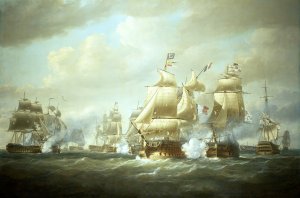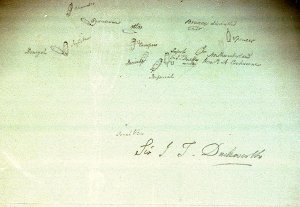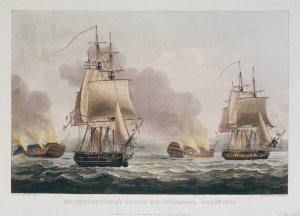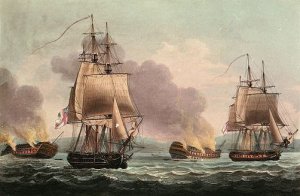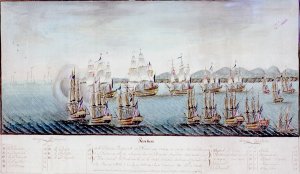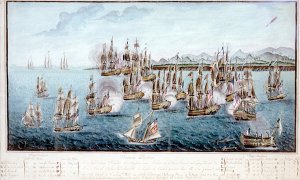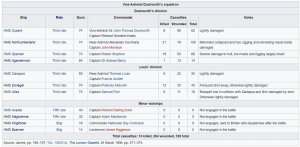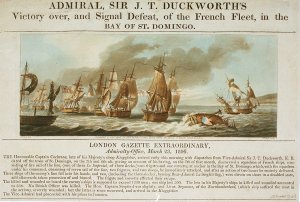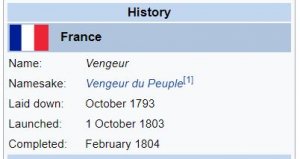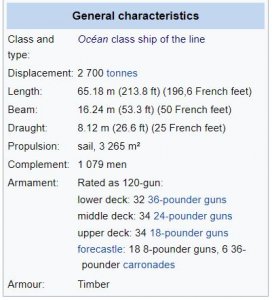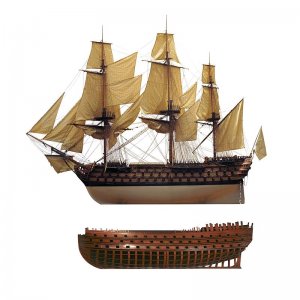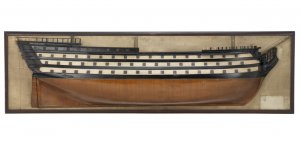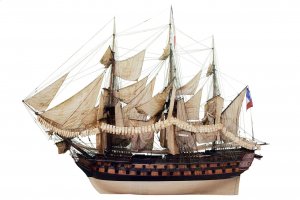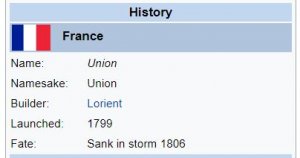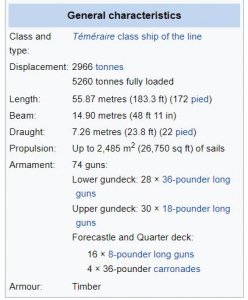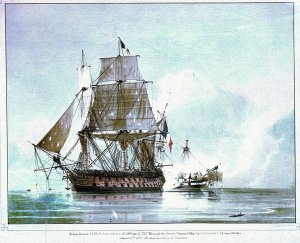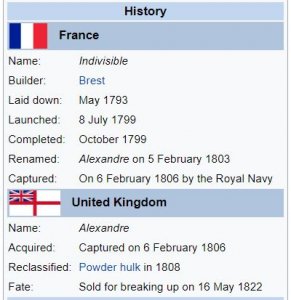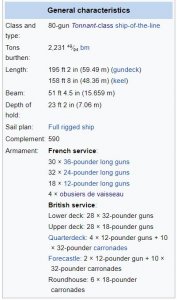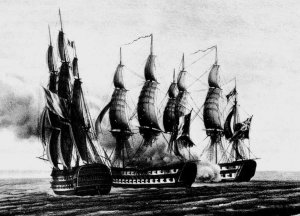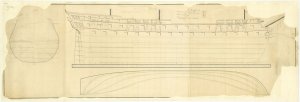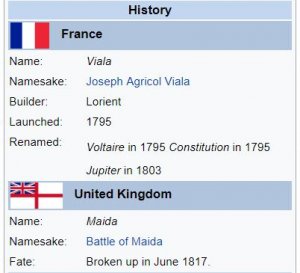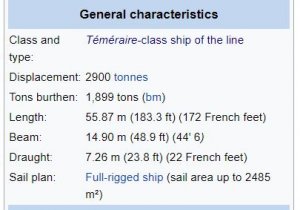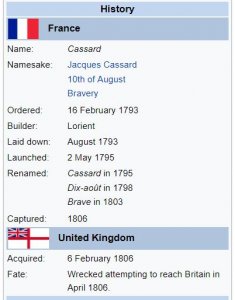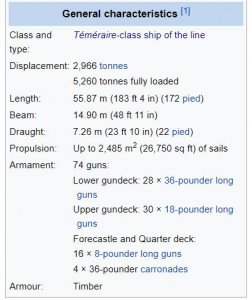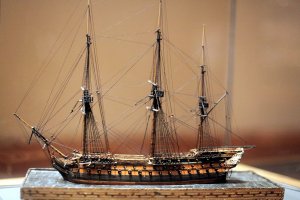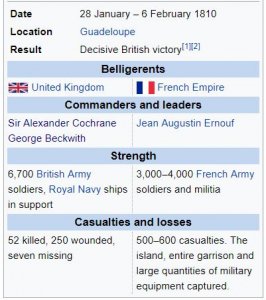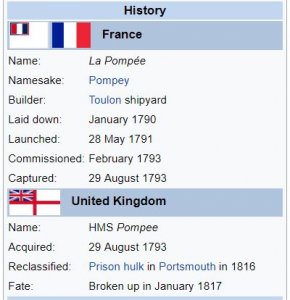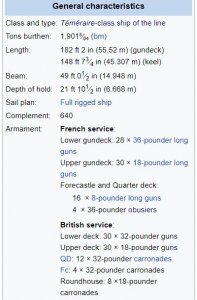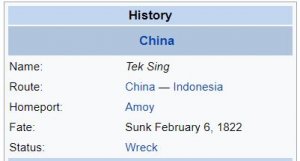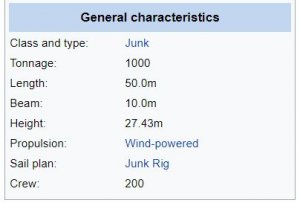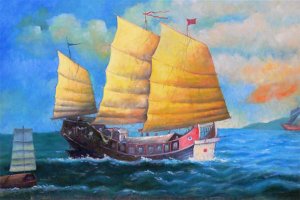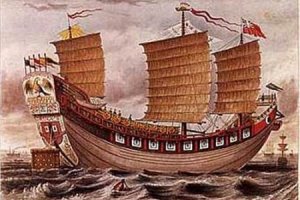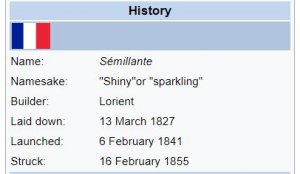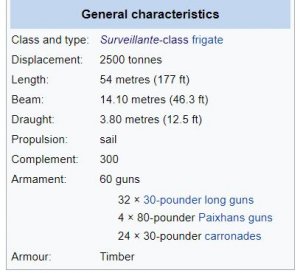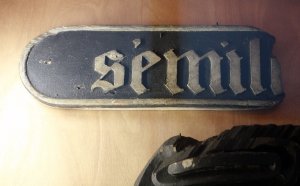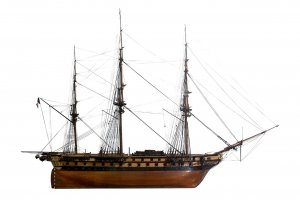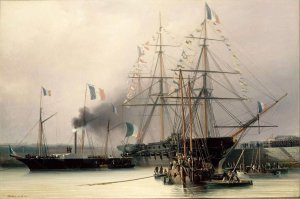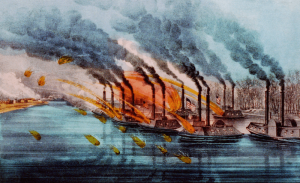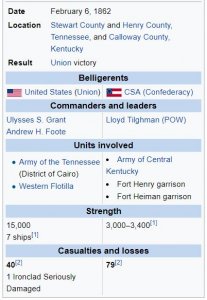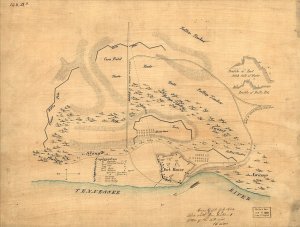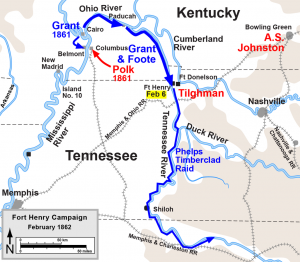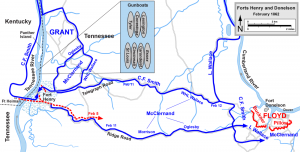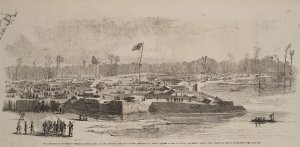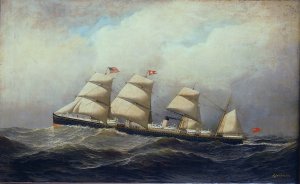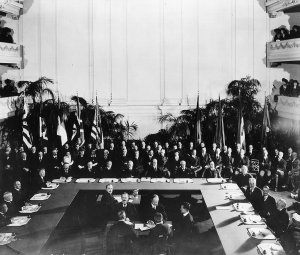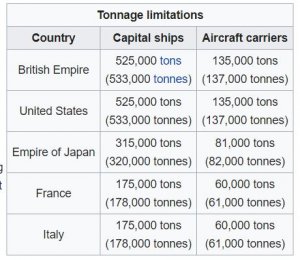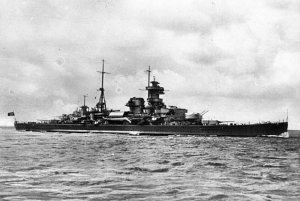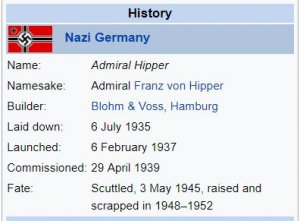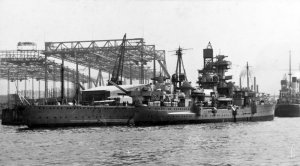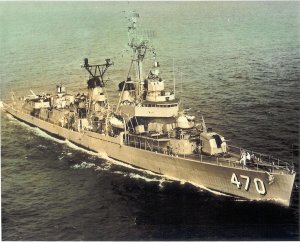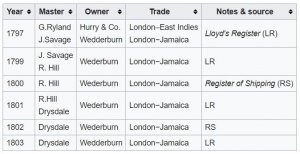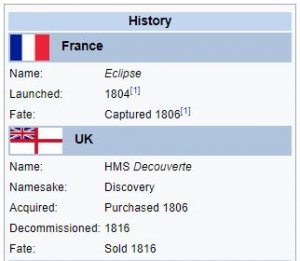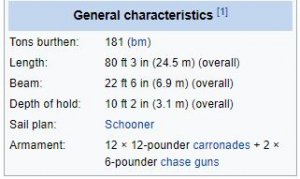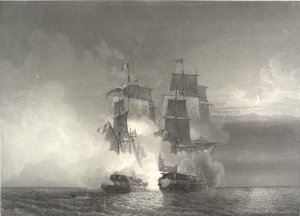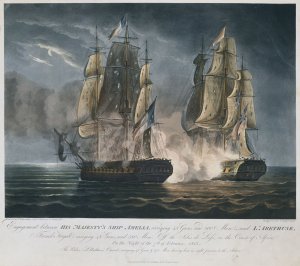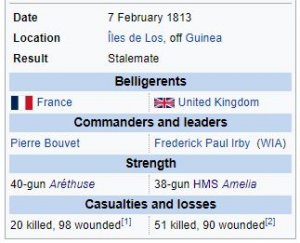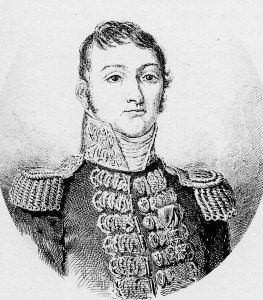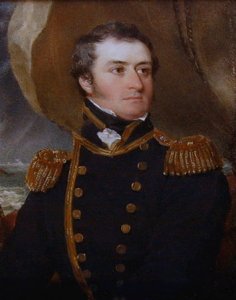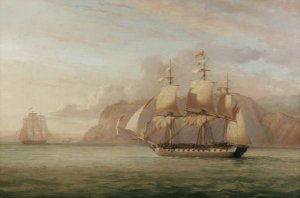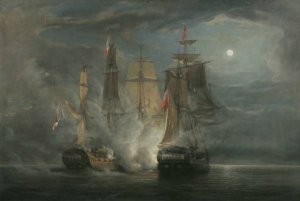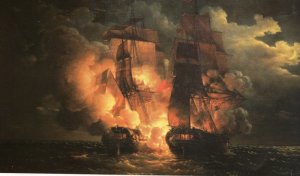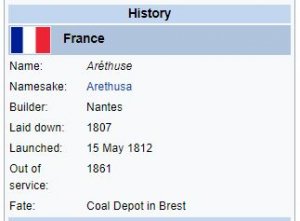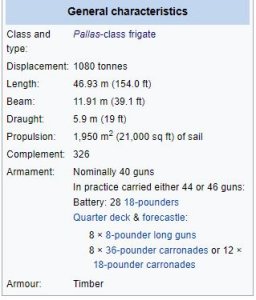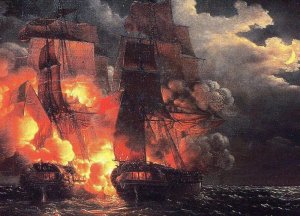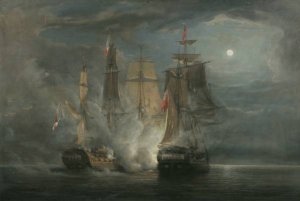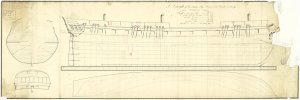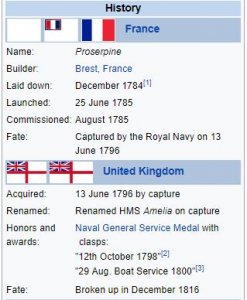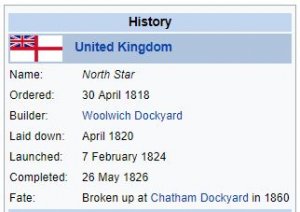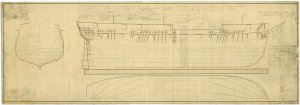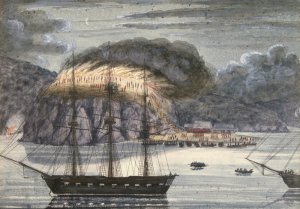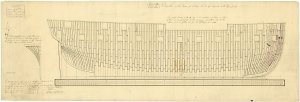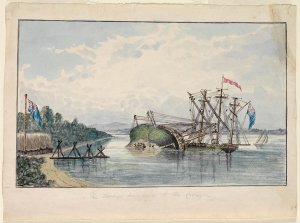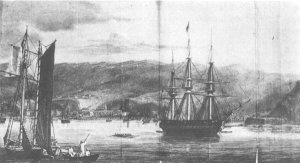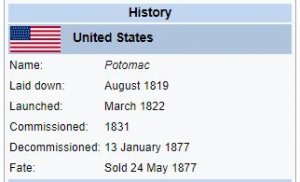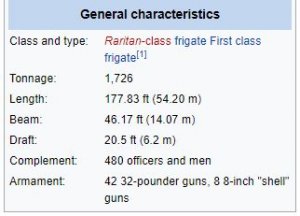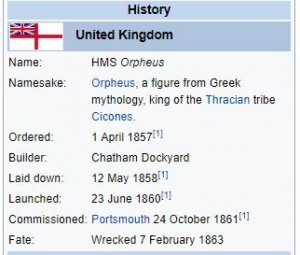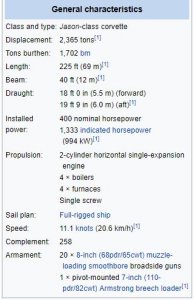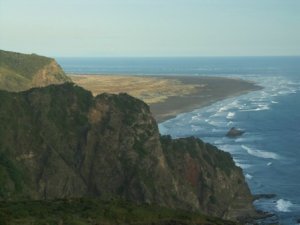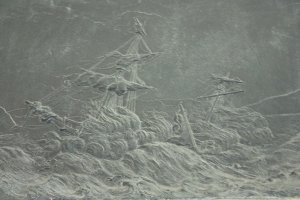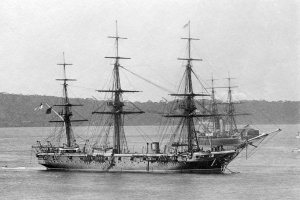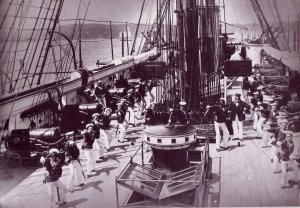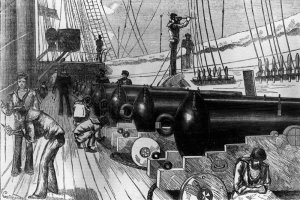Today in Naval History - Naval / Maritime Events in History
6 February 1806 – Battle of San Domingo - Part I
British naval victory against the French in the Caribbean.
The Battle of San Domingo was a naval battle of the Napoleonic Wars fought on 6 February 1806 between squadrons of French and British ships of the line off the southern coast of the French-occupied Spanish colonial Captaincy General of Santo Domingo (San Domingo in contemporary British English) in the Caribbean.
All five of the French ships of the line commanded by Vice-Admiral Corentin-Urbain Leissègues had been captured or destroyed. The Royal Navy led by Vice-Admiral Sir John Thomas Duckworth lost no ships and suffered less than a hundred killed while the French lost approximately 1,500 men. Only a small number of the French squadron were able to escape.
The battle of San Domingo was the last fleet engagement of the war between French and British capital ships in open water.
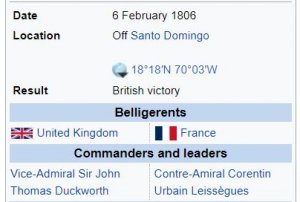
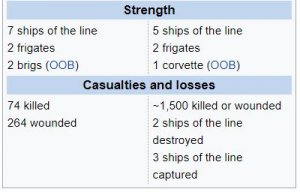
Background
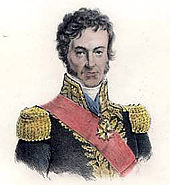
Vice-Admiral Corentin-Urbain Leissègues
In late 1805, First Lord of the Admiralty Lord Barham withdrew the Royal Navy blockade of the French Atlantic ports following the Trafalgar Campaign, in which the French Navy had lost 14 ships of the line. Barham believed that the French, having suffered such heavy losses, would be unable and unwilling to launch a major offensive in the Atlantic until after the winter. However, he had miscalculated the strength of the fleet at Brest, the principal French Atlantic seaport. The Brest fleet had not been engaged in the 1805 campaign and was therefore intact.
Taking advantage of the withdrawal of the British blockade, Emperor Napoleon ordered two squadrons to put to sea with orders to raid the British trade routes that crossed the Atlantic. These forces were to inflict as much economic damage to Britain as possible without engaging an equivalent British naval squadron and risking defeat and capture. The cruise was expected to last as long as 14 months, sustained by captured food supplies from British merchant ships. Sailing unopposed on 13 December 1805, the squadrons separated two days later in pursuit of British merchant convoys, one squadron steering for the South Atlantic under Contre-Admiral Jean-Baptiste Willaumez and the other, under Vice-Admiral Corentin-Urbain Leissègues, sailing for the Caribbean. The Admiralty in London did not discover that the French had sailed until 24 December, and the two squadrons they prepared in pursuit, under Rear-Admiral Sir Richard Strachan and Rear-Admiral Sir John Borlase Warren, did not sail until January 1806, by which time the French had disappeared into the Atlantic.
There was however one British squadron that had maintained contact with the French: since the Battle of Trafalgar in October 1805, the Admiralty had stationed a squadron under Vice-Admiral Sir John Thomas Duckworth off Cadiz to watch the remnants of the combined fleet. In November 1805, reports reached Duckworth of a French squadron operating against British convoys off the Savage Islands between Madeira and the Canary Islands. This squadron, which belonged to Contre-Admiral Zacharie Allemand, had left France in July 1805.[5] Immediately sailing to investigate, Duckworth abandoned Cadiz, leaving just two frigates to watch the Allied fleet at anchor. Passing the Savage and Canary Islands, Duckworth continued to the Cape Verde Islands before conceding that the French had escaped him and turning northwards again. Allemand was already far to the north. He eventually returned to France without incident on 23 December.
Duckworth's cruise
During his return journey to Cadiz, on 23 December Duckworth encountered HMS Arethusa under Captain Charles Brisbane escorting a small group of merchant ships. Leissègues had intercepted, chased and dispersed Brisbane's convoy in the Bay of Biscay on 15 December, Brisbane retaining only the largest merchant ships to help cover the flight of the smaller vessels. Once he had escaped Leissègues' pursuit, Brisbane sailed in search of support at Cadiz, continuing southwards after realizing that Duckworth was not at his appointed station. Immediately setting a course that he believed would intercept Leissègues, Duckworth turned to the northwest and on 25 December discovered an enemy squadron approximately 200 nautical miles (370 km) northwest of the Canary Islands. Duckworth ordered his squadron to pursue, the chase lasting throughout the day and continuing into 26 December, by which time it had become clear that his quarry was not Allemand. In fact, Duckworth had discovered Willaumez's squadron. However, the French admiral ordered his ships to run before Duckworth rather than give battle. By 13:00 on 26 December, it seemed certain that the British flagship, HMS Superb, would outstrip the rearmost French ship, when Duckworth suddenly called off the pursuit. He later claimed that he was concerned that the leading ships of his squadron would be overwhelmed by the concentrated French squadron before the stragglers, some of which were more than 45 nautical miles (83 km) behind Superb, could join the battle.

Vice-Admiral Sir John Thomas Duckworth
Henry William Beechey, 1809, National Maritime Museum
As Willaumez escaped into the South Atlantic, Duckworth ordered his squadron to sail for Barbados to resupply before making the long journey back to Cadiz. When he arrived on 12 January 1806, he ordered the frigate HMS Acasta to St. Kitts to arrange the required water supplies, and moved the squadron to an anchorage off Basseterreon 19 January. There two ships of the Leeward Islands squadron, HMS Northumberland and HMS Atlas, joined him. Northumberland was the flagship of Rear-Admiral Alexander Cochrane, commander of the station. Cochrane's arrival raised the number of admirals in the squadron to three, as Duckworth's second in command was Rear-Admiral Thomas Louis in HMS Canopus. Leissègues was also en route to the Caribbean, winter storms off the Azores having delayed him, separated Alexandre and Braveand inflicted damage on Jupiter and Diomède. Arriving at the French-held city of Santo Domingo on the island of Hispaniola on 20 January, Leissègues disembarked over 1,000 soldiers as reinforcements for the garrison, and made hasty repairs as he awaited the arrival of his missing ships, which appeared on 29 January. During his time in the harbour, Leissègues moved ashore and gave orders for the ships to be recaulked following their Atlantic voyage, a difficult and time-consuming process.
On 1 February the small sloop HMS Kingfisher arrived at Basseterre with information that three French ships of the line had been sighted off Santo Domingo. Duckworth gave orders for the fleet to sail immediately. On 3 February the brig HMS Epervier joined him at St. Thomas and on 5 February the frigate HMS Magicienne under Captain Adam Mackenzie joined near the Mona Passage. Mackenzie was accompanied by a Danish schooner that had sailed from Santo Domingo a few days before, and whose crew were able to provide a detailed account of the French squadron's composition. Before the schooner had sailed, a number of French officers had commented on the risk involved in allowing the vessel to leave port, but the admiral had refused their demands that he burn the Danish ship. Duckworth was now confident that he outnumbered and outgunned Leissègues. During the night of 5 February the British squadron slowly approached Santo Domingo, Acasta and Magicienne scouting ahead of the main fleet.
Battle
Duckworth's attack
At 06:00 on 6 February Duckworth's scouts sighted the French, observing two frigates, five ships of the line and one large merchant ship anchored in line at the entrance to Santo Domingo. Leissègues had reportedly issued orders for the squadron to sail for Jamaica, even though several of the French ships were not yet ready for sea, and two frigates were already under sail when the British arrived. Leissègues was not aboard Impérial; he and a number of his officers were still conducting their business in the town and were therefore forced to join the squadron in small boats, which delayed the squadron. Several officers, possibly including Leissègues, did not reach their ships until after the engagement had begun. Recognising that his enemy was in a vulnerable position, Duckworth raised all sail in an effort to close with the French. Leissègues too recognised the danger his ships were in and ordered them to raise anchor and then to sail westwards along the coast in the direction of Nizao. Maintaining close formation, the French formed a line of battle, Captain Pierre-Elie Garreau in Alexandre leading, with Impérial, Diomède, Jupiter and Brave following. The frigates and corvette took a position between the battle line and the shore. Duckworth was concerned that there might be other French forces to the west. He therefore angled his line of attack to pass across the front of the French line and signaled to his squadron to direct their fire at the front three ships: Alexandre, Impérial and Diomède.
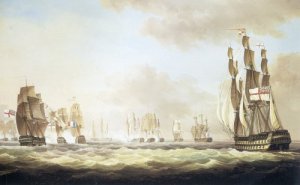
The Battle of San Domingo, 6 February 1806, with H.M.S. Canopus Joining the Action, Thomas Lyde Hornbrook
At 08:00 Duckworth's ships divided into two divisions, a westerly line to windward under Duckworth with Superb, Northumberland, HMS Spencer and HMS Agamemnon, and an eastern line under Louis with Canopus, HMS Donegal and Atlas. The British frigates were gathered in formation to the west of the British lines, awaiting orders to assist if required. Over the next two hours the British slowly closed with the French squadron, the British divisions breaking up as the faster ships outpaced the slower. Louis' squadron fell behind Duckworth's, while Agamemnon dropped behind the other three vessels in her division, which otherwise remained in a tight formation. A slight shift in the wind allowed Leissègues to adjust his direction to the southwest, but the close presence of the land restricted French movements and at 10:10 Superb was able to open fire on Alexandre.
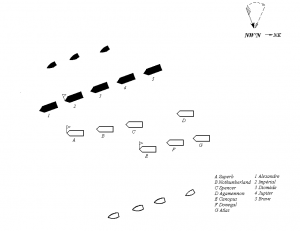
Positions of both fleets at around 10am
With the British flagship engaged with the leading French vessel, Northumberland opened fire on the next in line, Leissègues' flagship Impérial. The French ship carried 120 guns to Northumberland's 74, but Cochrane engaged closely, rapidly supported by Spencer, which opened fire on Impérial and Diomède simultaneously. For 15 minutes the British continued to close, both squadrons sailing westwards along the coast with the wind. At 10:25, the damaged Alexandre suddenly swung out of the line in an attempt to drive between Spencer and Northumberland and rake them both. Captain Robert Stopford on Spencer responded rapidly, turning across Alexandre's bow and raking her, before pulling along the opposite side of Garreau's Alexandre and opening fire from close range. In the smoke and confusion neither Superb nor Northumberland noticed Spencer's move; both fired several shots into Spencer before they realized their mistake.[18] With Spencer and Alexandre out of the way, Impérial was able to engage both of the leading British ships, threatening to overwhelm them. Cochrane moved to defend the flagship by pulling Northumberland between Impérial and Superb, suffering terrible damage but preserving Duckworth's ship intact. Impérial's fire was so heavy that several shot passed straight through Northumberland into Superb.
to be continued .........
https://en.wikipedia.org/wiki/Battle_of_San_Domingo
https://en.wikipedia.org/wiki/Order_of_battle_at_the_Battle_of_San_Domingo
6 February 1806 – Battle of San Domingo - Part I
British naval victory against the French in the Caribbean.
The Battle of San Domingo was a naval battle of the Napoleonic Wars fought on 6 February 1806 between squadrons of French and British ships of the line off the southern coast of the French-occupied Spanish colonial Captaincy General of Santo Domingo (San Domingo in contemporary British English) in the Caribbean.
All five of the French ships of the line commanded by Vice-Admiral Corentin-Urbain Leissègues had been captured or destroyed. The Royal Navy led by Vice-Admiral Sir John Thomas Duckworth lost no ships and suffered less than a hundred killed while the French lost approximately 1,500 men. Only a small number of the French squadron were able to escape.
The battle of San Domingo was the last fleet engagement of the war between French and British capital ships in open water.


Background

Vice-Admiral Corentin-Urbain Leissègues
In late 1805, First Lord of the Admiralty Lord Barham withdrew the Royal Navy blockade of the French Atlantic ports following the Trafalgar Campaign, in which the French Navy had lost 14 ships of the line. Barham believed that the French, having suffered such heavy losses, would be unable and unwilling to launch a major offensive in the Atlantic until after the winter. However, he had miscalculated the strength of the fleet at Brest, the principal French Atlantic seaport. The Brest fleet had not been engaged in the 1805 campaign and was therefore intact.
Taking advantage of the withdrawal of the British blockade, Emperor Napoleon ordered two squadrons to put to sea with orders to raid the British trade routes that crossed the Atlantic. These forces were to inflict as much economic damage to Britain as possible without engaging an equivalent British naval squadron and risking defeat and capture. The cruise was expected to last as long as 14 months, sustained by captured food supplies from British merchant ships. Sailing unopposed on 13 December 1805, the squadrons separated two days later in pursuit of British merchant convoys, one squadron steering for the South Atlantic under Contre-Admiral Jean-Baptiste Willaumez and the other, under Vice-Admiral Corentin-Urbain Leissègues, sailing for the Caribbean. The Admiralty in London did not discover that the French had sailed until 24 December, and the two squadrons they prepared in pursuit, under Rear-Admiral Sir Richard Strachan and Rear-Admiral Sir John Borlase Warren, did not sail until January 1806, by which time the French had disappeared into the Atlantic.
There was however one British squadron that had maintained contact with the French: since the Battle of Trafalgar in October 1805, the Admiralty had stationed a squadron under Vice-Admiral Sir John Thomas Duckworth off Cadiz to watch the remnants of the combined fleet. In November 1805, reports reached Duckworth of a French squadron operating against British convoys off the Savage Islands between Madeira and the Canary Islands. This squadron, which belonged to Contre-Admiral Zacharie Allemand, had left France in July 1805.[5] Immediately sailing to investigate, Duckworth abandoned Cadiz, leaving just two frigates to watch the Allied fleet at anchor. Passing the Savage and Canary Islands, Duckworth continued to the Cape Verde Islands before conceding that the French had escaped him and turning northwards again. Allemand was already far to the north. He eventually returned to France without incident on 23 December.
Duckworth's cruise
During his return journey to Cadiz, on 23 December Duckworth encountered HMS Arethusa under Captain Charles Brisbane escorting a small group of merchant ships. Leissègues had intercepted, chased and dispersed Brisbane's convoy in the Bay of Biscay on 15 December, Brisbane retaining only the largest merchant ships to help cover the flight of the smaller vessels. Once he had escaped Leissègues' pursuit, Brisbane sailed in search of support at Cadiz, continuing southwards after realizing that Duckworth was not at his appointed station. Immediately setting a course that he believed would intercept Leissègues, Duckworth turned to the northwest and on 25 December discovered an enemy squadron approximately 200 nautical miles (370 km) northwest of the Canary Islands. Duckworth ordered his squadron to pursue, the chase lasting throughout the day and continuing into 26 December, by which time it had become clear that his quarry was not Allemand. In fact, Duckworth had discovered Willaumez's squadron. However, the French admiral ordered his ships to run before Duckworth rather than give battle. By 13:00 on 26 December, it seemed certain that the British flagship, HMS Superb, would outstrip the rearmost French ship, when Duckworth suddenly called off the pursuit. He later claimed that he was concerned that the leading ships of his squadron would be overwhelmed by the concentrated French squadron before the stragglers, some of which were more than 45 nautical miles (83 km) behind Superb, could join the battle.

Vice-Admiral Sir John Thomas Duckworth
Henry William Beechey, 1809, National Maritime Museum
As Willaumez escaped into the South Atlantic, Duckworth ordered his squadron to sail for Barbados to resupply before making the long journey back to Cadiz. When he arrived on 12 January 1806, he ordered the frigate HMS Acasta to St. Kitts to arrange the required water supplies, and moved the squadron to an anchorage off Basseterreon 19 January. There two ships of the Leeward Islands squadron, HMS Northumberland and HMS Atlas, joined him. Northumberland was the flagship of Rear-Admiral Alexander Cochrane, commander of the station. Cochrane's arrival raised the number of admirals in the squadron to three, as Duckworth's second in command was Rear-Admiral Thomas Louis in HMS Canopus. Leissègues was also en route to the Caribbean, winter storms off the Azores having delayed him, separated Alexandre and Braveand inflicted damage on Jupiter and Diomède. Arriving at the French-held city of Santo Domingo on the island of Hispaniola on 20 January, Leissègues disembarked over 1,000 soldiers as reinforcements for the garrison, and made hasty repairs as he awaited the arrival of his missing ships, which appeared on 29 January. During his time in the harbour, Leissègues moved ashore and gave orders for the ships to be recaulked following their Atlantic voyage, a difficult and time-consuming process.
On 1 February the small sloop HMS Kingfisher arrived at Basseterre with information that three French ships of the line had been sighted off Santo Domingo. Duckworth gave orders for the fleet to sail immediately. On 3 February the brig HMS Epervier joined him at St. Thomas and on 5 February the frigate HMS Magicienne under Captain Adam Mackenzie joined near the Mona Passage. Mackenzie was accompanied by a Danish schooner that had sailed from Santo Domingo a few days before, and whose crew were able to provide a detailed account of the French squadron's composition. Before the schooner had sailed, a number of French officers had commented on the risk involved in allowing the vessel to leave port, but the admiral had refused their demands that he burn the Danish ship. Duckworth was now confident that he outnumbered and outgunned Leissègues. During the night of 5 February the British squadron slowly approached Santo Domingo, Acasta and Magicienne scouting ahead of the main fleet.
Battle
Duckworth's attack
At 06:00 on 6 February Duckworth's scouts sighted the French, observing two frigates, five ships of the line and one large merchant ship anchored in line at the entrance to Santo Domingo. Leissègues had reportedly issued orders for the squadron to sail for Jamaica, even though several of the French ships were not yet ready for sea, and two frigates were already under sail when the British arrived. Leissègues was not aboard Impérial; he and a number of his officers were still conducting their business in the town and were therefore forced to join the squadron in small boats, which delayed the squadron. Several officers, possibly including Leissègues, did not reach their ships until after the engagement had begun. Recognising that his enemy was in a vulnerable position, Duckworth raised all sail in an effort to close with the French. Leissègues too recognised the danger his ships were in and ordered them to raise anchor and then to sail westwards along the coast in the direction of Nizao. Maintaining close formation, the French formed a line of battle, Captain Pierre-Elie Garreau in Alexandre leading, with Impérial, Diomède, Jupiter and Brave following. The frigates and corvette took a position between the battle line and the shore. Duckworth was concerned that there might be other French forces to the west. He therefore angled his line of attack to pass across the front of the French line and signaled to his squadron to direct their fire at the front three ships: Alexandre, Impérial and Diomède.

The Battle of San Domingo, 6 February 1806, with H.M.S. Canopus Joining the Action, Thomas Lyde Hornbrook
At 08:00 Duckworth's ships divided into two divisions, a westerly line to windward under Duckworth with Superb, Northumberland, HMS Spencer and HMS Agamemnon, and an eastern line under Louis with Canopus, HMS Donegal and Atlas. The British frigates were gathered in formation to the west of the British lines, awaiting orders to assist if required. Over the next two hours the British slowly closed with the French squadron, the British divisions breaking up as the faster ships outpaced the slower. Louis' squadron fell behind Duckworth's, while Agamemnon dropped behind the other three vessels in her division, which otherwise remained in a tight formation. A slight shift in the wind allowed Leissègues to adjust his direction to the southwest, but the close presence of the land restricted French movements and at 10:10 Superb was able to open fire on Alexandre.

Positions of both fleets at around 10am
With the British flagship engaged with the leading French vessel, Northumberland opened fire on the next in line, Leissègues' flagship Impérial. The French ship carried 120 guns to Northumberland's 74, but Cochrane engaged closely, rapidly supported by Spencer, which opened fire on Impérial and Diomède simultaneously. For 15 minutes the British continued to close, both squadrons sailing westwards along the coast with the wind. At 10:25, the damaged Alexandre suddenly swung out of the line in an attempt to drive between Spencer and Northumberland and rake them both. Captain Robert Stopford on Spencer responded rapidly, turning across Alexandre's bow and raking her, before pulling along the opposite side of Garreau's Alexandre and opening fire from close range. In the smoke and confusion neither Superb nor Northumberland noticed Spencer's move; both fired several shots into Spencer before they realized their mistake.[18] With Spencer and Alexandre out of the way, Impérial was able to engage both of the leading British ships, threatening to overwhelm them. Cochrane moved to defend the flagship by pulling Northumberland between Impérial and Superb, suffering terrible damage but preserving Duckworth's ship intact. Impérial's fire was so heavy that several shot passed straight through Northumberland into Superb.
to be continued .........
https://en.wikipedia.org/wiki/Battle_of_San_Domingo
https://en.wikipedia.org/wiki/Order_of_battle_at_the_Battle_of_San_Domingo



